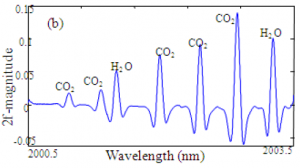By James Van Howe
 Wavelength Modulation Spectrum using tunable 2.0 micron VCSEL; From JTh1L.6, A. Kahn et al,. "Open-Path Green House Gas Sensor for UAV Applications"
Wavelength Modulation Spectrum using tunable 2.0 micron VCSEL; From JTh1L.6, A. Kahn et al,. "Open-Path Green House Gas Sensor for UAV Applications"
This post originally appeared on Jim’s Cleo Blog and is reproduced with permission of the author.
Today at CLEO I spent a large amount of time at the expo hunting down which companies were selling 2.0 micron wavelength products and why. In the technical program, there are a large number of contributed talks regarding 2.0 micron lasers, pulsed and continuous wave. On Monday I attended session CM1B, Ultrafast Mid-IR in which 5 out of 8 papers demonstrated ultrafast pulses about 2.0 microns. Today there was a session titled CTu2D, 1.5 to 5 micron Lasers which also had 5 talks out of 8 showing laser systems operating near 2.0 microns.
There have been and will be a handful of talks not pinned down to these topic categories as well:
-CM2B.2, “A Broadband 1850-nm 40-Gb/s Receiver Based on Four-Wave Mixing in Silicon Waveguides”
-CTu3M.7, “All-fiber 10-GHz Picosecond Pulse Generation at 1.9 microns without Mode-locking”
-JTh1L.6, “Open-Path Green House Gas Sensor for UAV Applications”
-CF1K.1, “Single-Frequency kHz-Linewidth 2-μm GaSb-Based Semiconductor Disk Lasers With Multiple-Watt Output Power”
-CF1N.4, “Double-wall carbon nanotube Q-switched and Mode-locked Two-micron Fiber Lasers”
However, what we like to research and what we can actually bring to market are often two very different things. I am therefore excited that it is not just 2.0 micron papers that are cropping up at this year’s conference, but 2.0 micron products at the expo as well.
So why is anyone interested in light in the 2.0 micron region? My personal interest stems from a research talk I saw by analytical chemist, Mark Arnold, at University of Iowa. Arnold is trying to perform some hard analytical chemistry on 2.0 micron light shone through the skin on the back of one’s hand. He hopes that by looking at the absorption spectra, he can measure blood glucose levels without having to draw blood. This noninvasive testing would be a boon to diabetics who are not thrilled about pricking their fingers regularly. Wavelengths that are helpful for pinning down glucose, but that are not absorbed as readily by tissue are 2.13 microns, 2.27 microns, and 2.33 microns.In short, there are some interesting molecules around 2.0 microns on which to perform spectroscopy. For environmental sensing, there is 1877 nm, a well defined water absorption line, and 2004 nm, a good line for carbon dioxide detection, and many more.
Many of the companies I spoke with selling 2.0 micron components and sources confirmed such spectroscopic applications of their customers:
-Oz Optics now sells passive fiber components at 2.0 microns as well as DFB sources.
-Sacher Lasertchnik and Nanoplus make DFB lasers extending through the 2.0 micron region depending on your molecule of interest.
-Advalue Photonics makes thulium-based fiber laser systems and sells passive 2.0 micron products.
-New Focus will be developing tunable laser diodes about 2.0 microns in the next few months.
-Nufern and CorActive are selling Tm- and Ho-doped fiber for 2.0 micron amplification and for fiber sources.
-IPG sells a number of lasers from 2.0-2.8 microns based Cr:ZnSe as well as 2.0 micron fiber lasers using thulium doped fibers.
There are other advantages to 2.0 micron light as well… (for a list of more companies and the rest of the post, click here)
Posted: 9 May 2012 by
James Van Howe
| with 0 comments